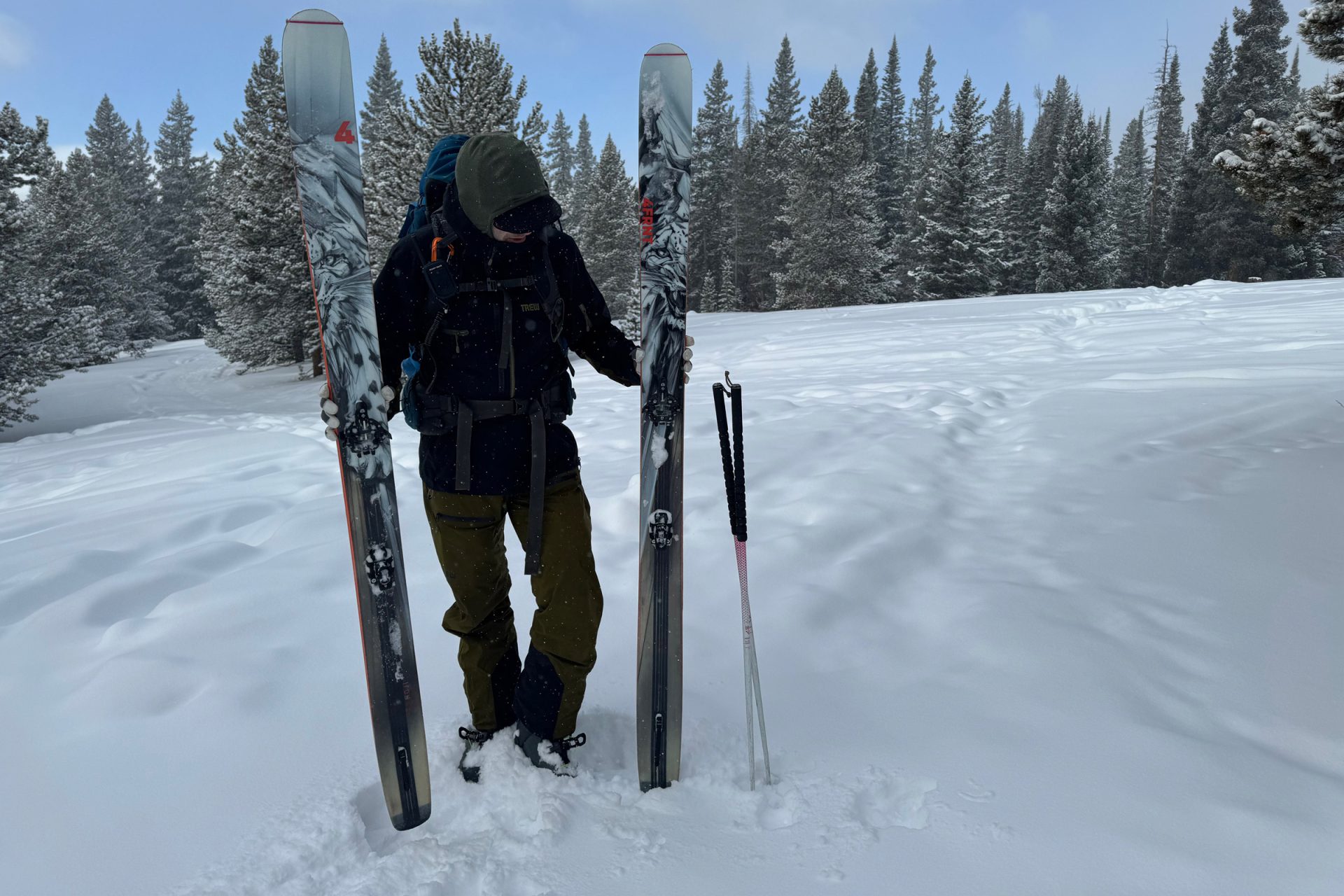4FRNT Hoji Ski With 4-Lock Pores and skin System Evaluate
It’s flu season and when 4FRNT’s new Hojis with 4-Lock confirmed up, I used to be struck — with powder fever. As if I wanted another excuse to be psyched about snowboarding powder; these first few turns within the deep stuff on board the 112mm underfoot powder ski had been what skiers dream about. I floated and slashed by way of fluffy snow effortlessly, pivoting, popping, leaping, and browsing.
The skis made me really feel like the boss, Eric “Hoji” Hjorleifson, himself.
Then El Niño set in and the powder stopped piling up. That was a bummer, but it surely additionally allowed me to check the ski and pores and skin system in a large spectrum of circumstances. Every part from fluffy coldsmoke powder to nasty breakable crust and hardpack.
There’s nothing conventional in regards to the Hojis apart from being made out of wooden. They’re reverse-cambered, practically center-mounted, shun sidecut, and include a gap punched in every tail. I endured a studying curve, however man, was it a enjoyable journey.
In brief: 4FRNT’s new Hoji skis ($979), now with their signature 4-Lock pores and skin system, transcend conventional ski design and pores and skin integration. Their totally reverse camber and slim sidecut numbers make them outlandishly enjoyable in deep snow. They’re powder skis by way of and thru. Due to an inexpensive weight-to-skiability ratio and built-in pores and skin system targeted on uphill effectivity, they’re at residence on the pores and skin monitor, however they’ll pull double obligation on the resort, too.
They’re not the fitting device for exhausting snow circumstances, and but they’re manageable when the snow developments towards tender. Superior and skilled skiers able to adapt to an modern ski form will likely be thrilled to hop on the Hojis when the powder begins piling up.
Dimensions
128-112-120 mm
Weight
2,066 g (191cm size)
Sidecut radius
30 m
Efficient edge
1,370 mm
Mount level from tail
885 mm
Tip top
92 mm
Tail top
37 mm
Phenomenal in powder
Exceptionally agile and fast turning
4-Lock is modern and safe pores and skin attachment system
Gentle for a hard-charging freeride ski
Misplaced in exhausting snow
4-Lock system requires proprietary components, which aren’t broadly accessible
4FRNT Hoji Skis With 4-Lock Pores and skin Locking System: Evaluate
4-Lock Pores and skin System
It’s inconceivable to overlook the outlet punched in every ski’s tail — the Hoji Gap. The model’s signature 4-Lock pores and skin system makes use of the outlet so as to add extra safety to the pores and skin attachment. The model claims that this locking system eliminates pores and skin failure and reduces their carry weight. You should purchase the Hojis with or with out this method.
Donning the 4-Lock skins is straightforward. It’s so simple as looping the tip clip over the ski’s tip, lining up the pores and skin over the ski, and threading the tail tether and 4-Lock block by way of the 12x9mm Hoji Gap.
A satisfying snap lets it’s locked. It takes about so long as some other pores and skin.
It took me a couple of days to nail the tour-to-ski transition, although. At first, the 4-Lock block was harder to govern with one gloved hand than a typical tail clip. For some time, it felt like attempting to drag a sq. peg by way of a spherical gap. The tolerances felt tight.
Then after weeks of snowboarding the system, I noticed that I had arrange the tail block backward. Once I flipped it round, it popped out and in of the ski like butter. Whole consumer error on my half. They launch simply as quick as different skins.
The 4-Lock system does one factor higher than some other pores and skin system that I do know of: Lock pores and skin to ski. Even when my skins froze after a bunch of laps in freezing, powdery circumstances, the pores and skin stayed locked to the ski. They slid round slightly bit, however I by no means dropped a pores and skin. In actual fact, I haven’t dropped a pores and skin or a tail clip as soon as all season, and that’s a purpose to have a good time.
Proprietary components and fittings can get annoying quick. Simply ask mountain bikers. You’ll want the proprietary Pomoca pores and skin with the particular 4FRNT tail clip to make use of the Hoji Gap. Like with different proprietary components, that raises two points. First, you’re beholden to 4FRNT’s inventory of 4-Lock skins, and second, you’ve solely acquired one pores and skin alternative.
I’m not fretting about both of these caveats, although. You possibly can all the time slap a distinct pores and skin with a standard tail clip onto the Hojis and skip the Hoji Gap. The ski’s tail isn’t notched, nonetheless, so the pores and skin will slide off every so often. If I had been going this route long-term, I’d escape the Dremel and add a notch myself.
Fortuitously, 4FRNT and Hoji went with among the finest skins in the marketplace for the 4-Lock System. So, it’s not such as you’re caught with a lemon. I’ve been on a number of pairs of the Pomoca Free Professionals through the years, they usually’re slick. Actually, they’re slick in that their pure mohair glide is sort of a skimo race pores and skin. In actual fact, it’s the identical formulation that Pomoca makes use of of their race skins. They’re additionally tremendous skinny, mild, and pack up small.
However excessive efficiency comes at a price. At $230, they aren’t low-cost. Additionally they don’t final so long as Pomoca’s different choices with nylon blended into the formulation. Being so skinny, they’re additionally probably the most weak to tears. I’ve gotten two seasons out of a pair prior to now, however simply barely. To this point, the proprietary 4FRNT-branded Free Professional 2.0s have been flawless and present little or no signal of wear and tear.
Snowboarding the Hoji
No one will likely be shocked to listen to that the Hojis are extremely enjoyable in powder. At one level, I wrote a notice in my pocket pocket book whereas testing the skis on a powder day: “As a lot enjoyable as you’ll be able to have on skis.”
I stand by it. They had been simply so dang enjoyable within the fluffy stuff. That they had that buoyant, unsinkable floaty feeling. The purest euphoria. It was powerful to remain goal and never fall in love immediately. I mentioned it already and I’ll say it once more: They made me really feel like Hoji himself.
The totally reverse camber makes these skis float each higher and extra effortlessly than their dimensions would recommend. They aren’t loopy vast by any means at 128-112-120. The sidecut is minimal, too. But the ideas refuse to sink.
The reverse camber additionally makes them significantly nimble. They pivot and launch from turns remarkably properly, so it was straightforward to shortly change path and pace when the terrain demanded it. They by no means felt overly demanding regardless of the lengthy 191cm size I examined (I’m 185cm tall, for reference). Different adjectives to explain their powder efficiency? Playful, floaty, secure, intuitive, damp, and rad.
So little sidecut gave them a “ship it” angle in the fitting circumstances. I felt like I might cost and level it straight, soar round, and energy by way of absolutely anything. And so they didn’t really feel like an unstoppable freight prepare — I used to be nonetheless capable of shut it down and dump pace shortly with pivoty pace checks.
They excelled in tender, uneven snow, too. Their tapered ideas enable them to slice by way of messy snow with out hooking or feeling squirrely. Their aspen/maple core felt damp and predictable whereas remaining energetic. They didn’t deflect erratically or bounce me into the backseat like I half anticipated.
I beloved how simply they launched from turns in tender chop too — they by no means felt locked right into a line. It made them really feel versatile and fast in sophisticated terrain like skied-out bushes and cliffy faces.
They had been decently enjoyable on groomers and tender piste once I took them up on the resort. They’ve an enormous 30m flip radius and wish to go quick. The Hojis by no means felt like there was a complete lot of edge digging into the snow, although. You actually need to push energy into the underfoot part of the ski and deal with a centered snowboarding stance to get them to chew.
It took some getting used to. I needed to adapt my pure ahead stance to one thing extra centered.
Exhausting Snow
I wasn’t as enamored with their exhausting snow skiability. It’s the alternative of the place they’re designed to excel. They might make it down something, but it surely wasn’t fairly or enjoyable in hardpack.
The reverse camber and ahead mount meant there wasn’t a lot to push into up entrance till I actually leaned the ski over on its edge. So little edge size on the snow meant they didn’t really feel exact, nor did they cease shortly.
I ended up washing out once I pushed into my boots’ tongues, and the entire expertise felt sloppy. Even after adopting a extra centered stance, I ended up sliding round greater than arcing large turns in exhausting snow.
They’re powder skis, in spite of everything. However even some powder skis, particularly ones with some conventional camber, really feel extra composed and secure in exhausting snow. My previous 4FRNT Kye 110s from 2015 (which I refuse to let die) are an awesome instance. The Hojis felt misplaced with so little edge contact.
Regardless of their exhausting snow efficiency, they skied higher in less-than-ideal circumstances which are so widespread within the backcountry. They had been capable of navigate breakable crust, wind-affected snow, and even low snow situations higher than typical cambered touring skis. They resisted getting locked into difficult circumstances, and it felt simpler to hop round and launch from turns than I’m used to.
4FRNT Hoji Skis’ Weight
The Hojis aren’t significantly mild at 2,066 g within the 191cm dimension, however I feel 4FRNT discovered a considerate steadiness between weight and skiability. In the event that they had been a lot lighter, they might absolutely lose a few of their freeriding prowess. They might get squirrely quick with all that rocker fore and aft with out a little little bit of heft protecting issues damp and secure.
Whereas some devoted backcountry skiers scoff at something over 1,500 g, the Hoji is a specialised powder device. It’s not the ski for mild and quick adventures or mega-long days on the pores and skin monitor.
By minimizing weight in my boot and bindings, I used to be capable of put collectively a comparatively light-weight bundle that ended up being greater than cheap for a devoted backcountry ski.
That began with my 1,280g Fischer Transalp Carbon Professional Boots, that are the lightest boots I’ve tried which are substantial sufficient to drive a ski this large. They powered the 191cm Hojis by way of powder and tender chop, and I didn’t die in breakable crust.
After debating going with a 50/50 resort/backcountry binding like Marker’s Kingpin, I mounted the Hojis up with my favourite light-weight touring binding, Marker’s Alpinist 12. At 540g per pair, they’re about as mild as you’ll be able to go whereas nonetheless having some heel elasticity. They’ve helped preserve the entire bundle fairly light-weight whereas retaining good, damp snowboarding traits.
The Hojis glide like a a lot narrower, lighter ski than their specs would recommend as a result of there isn’t any extra pores and skin involved with the snow due to the reverse camber. The flip aspect is that they don’t grip as properly on steep, icy switchbacks as one thing with extra skin-to-snow contact.
I’ll take the higher glide, although — it reduces the trouble of hauling such an enormous ski uphill. You possibly can all the time mitigate a scarcity of grip with extra kick turns.
4FRNT Hoji Skis: Who Are They For?
It took me a couple of days to attach with the Hojis in circumstances apart from powder. Their reverse camber and lengthy flip radius wouldn’t be the simplest combo for intermediate or newbie skiers. As a substitute, they’re for superior and skilled skiers searching for a specialised powder ski who’re prepared to adapt their snowboarding type.
I wouldn’t think about the Hoji to be probably the most versatile one-ski quiver or a every day driver for resort or backcountry except you’re fortunate sufficient to reside the place the snow by no means stops falling. They’re devoted powder skis that may operate nice inside or exterior the resort boundary. They’re mild sufficient for backcountry when paired with a light-weight boot and binding, however sturdy and highly effective sufficient for quick and unfastened freeriding.
Conclusion
Wish to ski just like the Boss when the fluffy snow is stacking up? The Hojis will take you there. They’re phenomenally enjoyable, nimble freeride powder skis. They’re not the fitting ski for hard-snow circumstances, however they arrive alive when the snow is tender.
Plus, they’ve a trick up their sleeve: The modern 4-Lock pores and skin system. It drops the load additional on a light-enough-for-touring bundle and boosts the pores and skin monitor glide. And whereas it comes with a proprietary components dilemma, it refuses to drop skins. They’re locked on there.
Superior freeriders searching for an distinctive, devoted powder ski that may tour the backcountry or shred powdery strains on the resort will likely be thrilled with the Hoji in the fitting circumstances. Throw the 4-Lock skins within the cart, too. They’re a step ahead in pores and skin evolution.
The post 4FRNT Hoji Ski With 4-Lock Pores and skin System Evaluate appeared first on Havens travel and tour blog .




